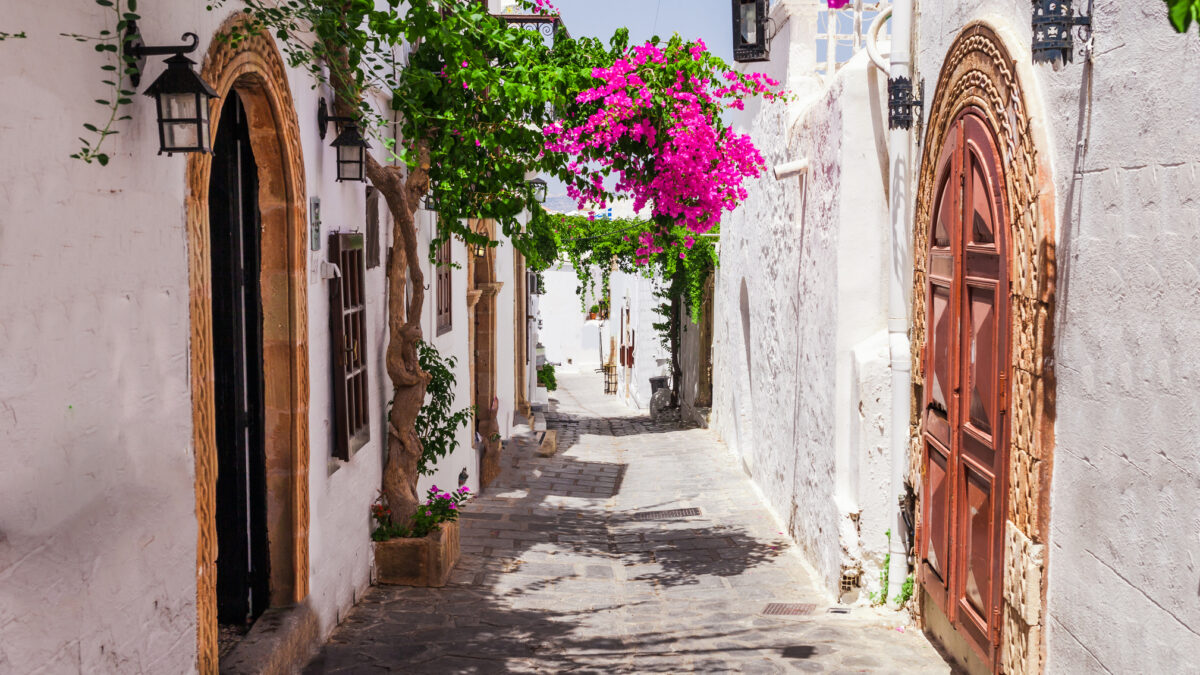Rhodes is the largest island in the Dodecanese. It is also the fourth largest in Greece and ninth largest in the Mediterranean. Located in the southeastern Aegean, Rhodes sits between the Aegean Sea to the west and the sea of Rhodes to the east. The island’s capital is the town of Rhodes or the Old Town, as it’s known to the locals. It is home to the majority of the island’s permanent population – Rhodes is one of Greece’s most populous islands – and has a thriving tourism industry. Visitors can explore the Medieval Town of Rhodes within the old fortifications, a UNESCO World Heritage Monument and the most impressive sightseeing draw on the island. Standing tall amongst the other old buildings here is the Palace of the Grand Master of the Knights of Rhodes, a testament to Rhodes’ history as the “island of the knights”. The island’s name refers to roses (rhodon, in Greek), flowers that have long been associated with it and that even appeared on ancient coins minted here. The Byzantine architecture is unique to the Medieval Town and is not seen in the island’s traditional villages. The latter are known instead for their rustic character, with their white houses and winding alleyways. Also worth a visit is Lindos, with its ancient acropolis and gorgeous beach. The quaint local village, a picturesque locale that feels almost disconnected from the rest of Rhodes, is one of the island’s most popular spots. Its cobblestone paths, whitewashed houses, romantic gardens and bougainvillea are sure to charm any who take a stroll through it. Naturally, thanks to its extensive coastline, Rhodes has a wealth of beaches with crystal-clear waters, numerous amenities, water sports and resort hotels. Tsampika, Anthony Quinn, Afantou, Plaka, Agathi, Lindos Beach and Aghios Pavlos are just a few of these. Rhodes is steeped in historical and natural monuments for visitors to explore, such as the Valley of the Butterflies, as well as a plethora of locales, such as Kallithea Springs.
Cuisine
The cuisine of Rhodes is a fusion, drawing recipes and techniques from Europe, Asia and Africa alike, all permeated by its unmistakable Mediterranean dimension. Olives play a leading role in the lives of the locals, as the soil is particularly suited to olive tree cultivation, producing premium-quality olive oil. Grains and, by extension, pasta such as trahanas and hilopites, as well as bulgur wheat, are a major aspect of the island’s cuisine and are encountered in many local dishes. And of course, vineyards blanket the more mountainous regions of Rhodes, producing a variety of exciting wines.
A key ingredient in the island’s cuisine is cumin, which is used abundantly in just about every local dish. Also unique to the island’s cuisine is the use of the plant cyclamen. The locals make dolmades out of its leaves, while its heart is made into a truly unique spoon sweet found nowhere else in the world. Popular dishes include purslane and sauteed greens, chicken with bulgur, pitaroudia, fish with trahanas, karavoloi (snails cooked in various ways, most frequently either in a red sauce reminiscent of stifado or with bulgur) and the famous lakani (goat baked in an earthenware vessel accompanied by chickpeas, thick-cut pasta and plenty of cumin). As far as sweets go, the island’s local melekouni is the most renowned and popular. Reminiscent of pasteli at first glance, it is nevertheless soft instead of crunchy and is made with sesame, almonds and various spices, such as cinnamon and cloves. Tahini pies, mantinades (local xerotigana, a type of local fried dumpling) and jam made from an indigenous variety of apricot round out the picture regarding confections.
How to get there
Rhodes belongs to the Dodecanese and is easily accessible by ferry from the port of Piraeus as well as by air.










